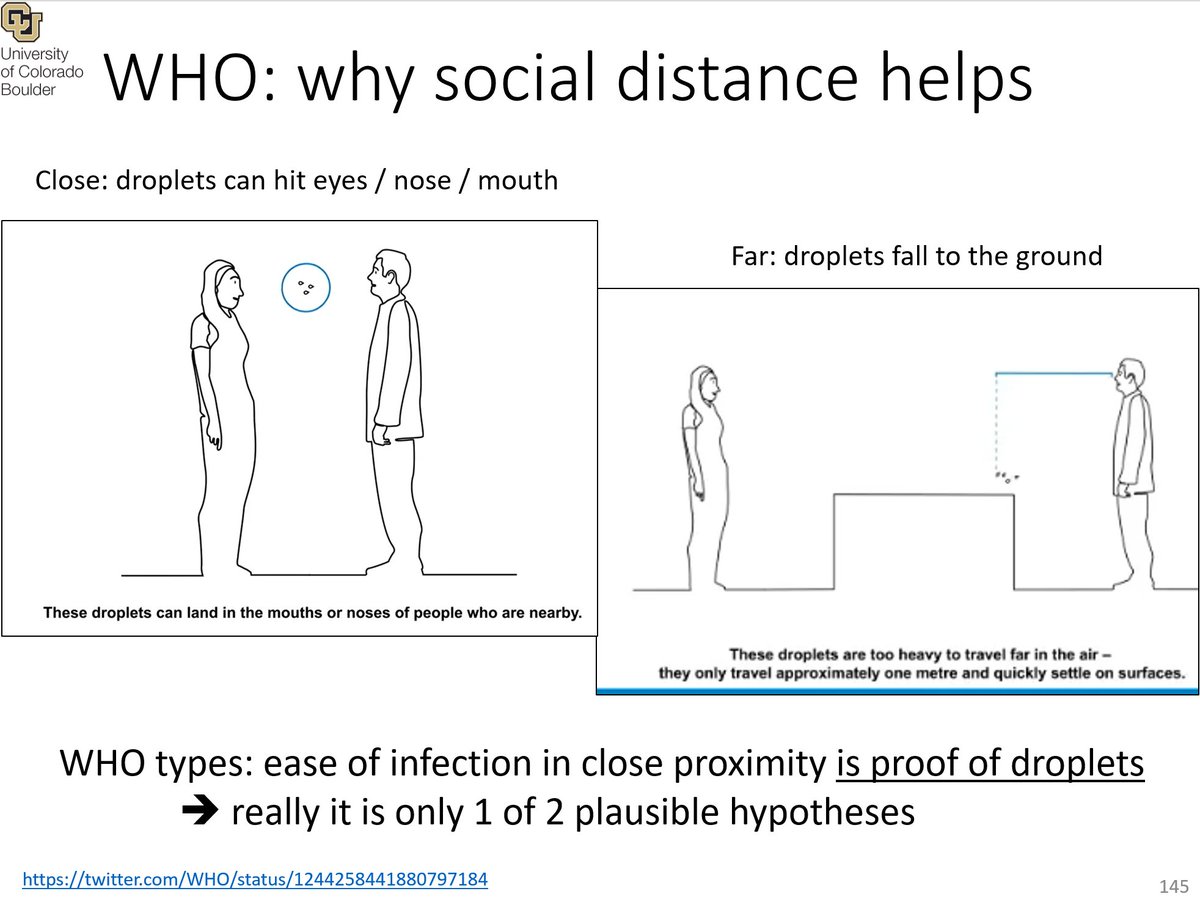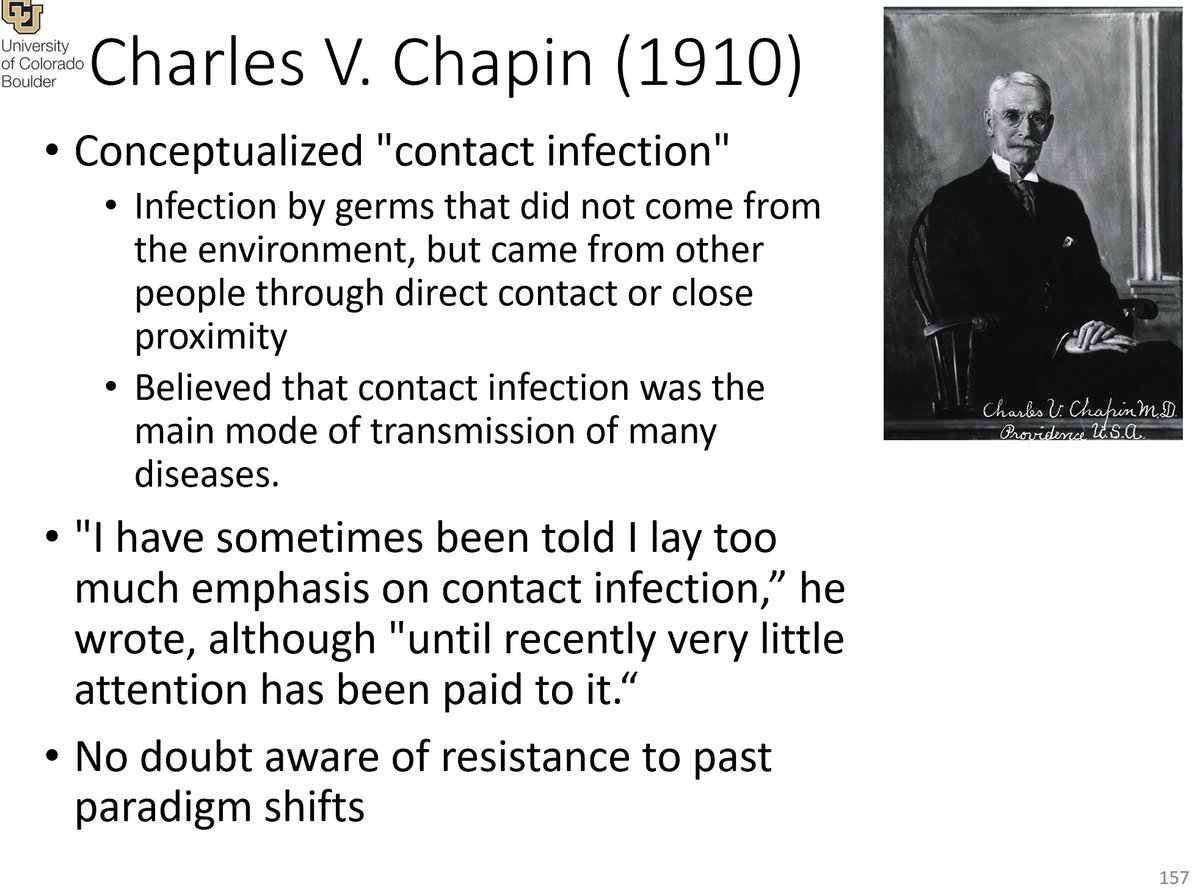
1/ Why is there such EXTREME RESISTANCE by @WHO, @CDCGov and IPC(*) to clearly state that COVID-19 is a dominantly AIRBORNE disease?
TLDR: see slide
*: IPC: Infection Prevention and Control scientists and professionals
TLDR: see slide
*: IPC: Infection Prevention and Control scientists and professionals

2/ This is extremely puzzling, as it is now extremely obvious that airborne transmission is DOMINANT for COVID-19.
There are mountains of evidence, e.g. as summarized in our @TheLancet publication.
And NO evidence whatsoever for droplets or surfaces!
There are mountains of evidence, e.g. as summarized in our @TheLancet publication.
And NO evidence whatsoever for droplets or surfaces!
https://twitter.com/jljcolorado/status/1383566908797059078
3/ I've pondered this question a lot. I've been involved in discussions with @WHO, many IPC and public health researchers and practitioners, politicians in multiple countries etc.
This thread summarizes my understanding of the causes of this situation. I look forward to comments
This thread summarizes my understanding of the causes of this situation. I look forward to comments
4/ Early in pandemic, a major historical error in the understanding of the IPC field played a major role
"Droplet transmission" was an important concept in that field... and it is an error that dates from 1910!!
This thread has long version (here short):
"Droplet transmission" was an important concept in that field... and it is an error that dates from 1910!!
This thread has long version (here short):
https://twitter.com/jljcolorado/status/1391111720526024708
5/ The concept of "sprayborne droplet transmission" was used by Charles Chapin (en.wikipedia.org/wiki/Charles_V…), a prominent US Public Health researcher (later pres. of APHA), to explain the EMPIRICAL OBSERVATION that transmission increases in close proximity and decreases with distance
6/ As of the start of the pandemic, @WHO and @CDCgov were completely stuck on the concepts from Chapin (e.g. his seminal 1910 book: ), as exemplified by this @WHO video showing the sprayborne droplets as explanation why distance reduces transmission:

https://twitter.com/WHO/status/1244258441880797184

7/ The problem is that Chapin had made an error. He was pushing "contact infection" that he had conceptualized, and encountered a lot of resistance (his book: archive.org/details/source…). 

8/ Chapin was very intelligent, and was well aware that short-range airborne transmission could also explain why distance reduced transmission: we breathe less exhaled air from someone else as we increased distance


9/ In Chapin's attempts to win acceptance for the importance of his theory of contact infection, he encountered a problem: there was a lingering belief on miasma, transmission of diseases through the air, that REALLY got in his way:
archive.org/details/source…
archive.org/details/source…

10/ So Chapin just decided to "discard airborne transmission". Unfortunately, was TOO successful, his views became totally dominant in IPC. Airborne transmission nearly impossible
Wells tries to prove otherwise in 1930s, encounters extreme resistance (en.wikipedia.org/wiki/William_F…)
Wells tries to prove otherwise in 1930s, encounters extreme resistance (en.wikipedia.org/wiki/William_F…)
11/ Some ppl question how a 1910 researcher could have so much influence to this day
They key is that Chapin's doctrine was foundational during the creation of the @CDCgov, CDC epi branch built on that error!
From there, went everywhere (@WHO etc.)
pubmed.ncbi.nlm.nih.gov/8857841/
They key is that Chapin's doctrine was foundational during the creation of the @CDCgov, CDC epi branch built on that error!
From there, went everywhere (@WHO etc.)
pubmed.ncbi.nlm.nih.gov/8857841/

12/ Fast forward to 2020: Lidia Morawska's "group of 36 scientists" meets with @mvankerkhove and @WHO IPC committee and for COVID-19 (w/ 6 handwashing experts and 0 airborne experts, for a NEW DISEASE with UNKNOWN transmission!)
who.int/publications/i…

who.int/publications/i…


13/ The meeting (in which I participated) doesn't go well. @WHO & its committee rudely told us that they were TOTALLY CLOSED to the idea that airborne transmission is important for COVID-19
We are told that we need to "wash hands fanatically" (Dr. Seto)
wired.com/story/the-teen…
We are told that we need to "wash hands fanatically" (Dr. Seto)
wired.com/story/the-teen…

14/ We went back to researching it, and started uncovering lots of evidence of airborne transmission, e.g. the Skagit Choir case early on, which we were already working on when we met with @WHO.
OBVIOUS airborne transmission
OBVIOUS airborne transmission
https://twitter.com/jljcolorado/status/1306450428867964930
15/ A key issue in this denial of airborne is sociological.
A proud field (IPC) had a foundational error (droplet transmission) for over a century.
And the people pointing out the error to them were mostly outsiders!!
Repeatedly call us ignorant (e.g. livescience.com/coronavirus-ai…)
A proud field (IPC) had a foundational error (droplet transmission) for over a century.
And the people pointing out the error to them were mostly outsiders!!
Repeatedly call us ignorant (e.g. livescience.com/coronavirus-ai…)

16/ As of last summer (2020) I was still naïve, hoping that once we explained the scientific error and the correct mechanism of transmission, the IPC and @WHO folks would understand that COVID was indeed airborne.
I wrote threads such as this one:
I wrote threads such as this one:
https://twitter.com/jljcolorado/status/1295518786951319552
17/ But this hope does not materialize.
In Nov. 2020, when the evidence of airborne trans. is overwhelming, @WHO suddenly starts to say that ventilation is very important.
No mention of WHY (but Vent. works for airborne, NOT for droplets or surfaces!)

In Nov. 2020, when the evidence of airborne trans. is overwhelming, @WHO suddenly starts to say that ventilation is very important.
No mention of WHY (but Vent. works for airborne, NOT for droplets or surfaces!)
https://twitter.com/jljcolorado/status/1323279393725194240

18/ Around May 2021 @mvankerkhove of @WHO admits in an interview that COVID is airborne, but they are avoiding using the word.
So history set us up to this point, but the current reasons are mostly different.
wired.com/story/the-teen…
So history set us up to this point, but the current reasons are mostly different.
wired.com/story/the-teen…

19/ My impression of the current reason is that we have an unholy alliance:
1) Some @WHO personnel & prominent IPC scientists (e.g. John Conly) DO NOT want to lose face.
@WHO gaslights us, saying that they have ALWAYS said it was airborne (yeah, right)
1) Some @WHO personnel & prominent IPC scientists (e.g. John Conly) DO NOT want to lose face.
@WHO gaslights us, saying that they have ALWAYS said it was airborne (yeah, right)
https://twitter.com/who/status/1243972193169616898?lang=en
20/ More importantly, governments & hospitals don't want the costs & restrictions that come along with admitting airborne
https://twitter.com/jljcolorado/status/1468601338502258698
21/ So:
- Scientifically obvious for > 1 yr that COVID-19 is dominantly airborne
- Mitigations incorrect in many places for this reason (e.g. Swiss Parliament:
- More ppl get infected, prolonging pandemic & suffering
- @WHO & govs. refuse to explain it
- Scientifically obvious for > 1 yr that COVID-19 is dominantly airborne
- Mitigations incorrect in many places for this reason (e.g. Swiss Parliament:
https://twitter.com/jljcolorado/status/1468370934239272966)
- More ppl get infected, prolonging pandemic & suffering
- @WHO & govs. refuse to explain it
22/ I think at this point it is fair to say that the refusal to say & explain clearly that COVID is an airborne disease amounts for criminal negligence from @WHO, IPC etc.
They have power, and I suspect they'll wait out the pandemic and not admit it. Continue to gaslight etc.
They have power, and I suspect they'll wait out the pandemic and not admit it. Continue to gaslight etc.
23/ Early on we were a few scientists working on this. But now tons of people, including some in epidemiology, ID, IPC understand the error and are working with us.
E.g. @trishgreenhalgh @DFisman @lisa_iannattone @denise_dewald @jvipondmd @venessb @microlabdoc & many many more
E.g. @trishgreenhalgh @DFisman @lisa_iannattone @denise_dewald @jvipondmd @venessb @microlabdoc & many many more
24/ We have to keep fighting, if not for this, for the next pandemic.
Right now it seems that IPC, @WHO, and governments will NEVER accept any pandemic is airborne, because IT IS TOO COSTLY! (
We have to keep fighting. Please help us increase pressure!
Right now it seems that IPC, @WHO, and governments will NEVER accept any pandemic is airborne, because IT IS TOO COSTLY! (
https://twitter.com/jvipondmd/status/1470164993765097472)
We have to keep fighting. Please help us increase pressure!
25/ If you want more detail and links to publications on the history, evidence of transmission, see this thread, and threads and papers linked therein:
https://twitter.com/jljcolorado/status/1461356173081276420
26/ If you just want to know the practical implications of how to protect ourselves better from transmission (works for all variants), see this thread:
https://twitter.com/jljcolorado/status/1463200650494316550
27/ And a summary of the reason we are stuck, from medical doctor @lisa_iannattone:
https://twitter.com/lisa_iannattone/status/1374551573544714241
28/ As some folks are pointing out, in more litigious societies like the US, part of the costs take the form of legal liability:
https://twitter.com/andy_utoronto/status/1470426556317278209
29/ Example of problem this denial gets us in: former head of @CDCgov explains airborne transmission in verbose way, dancing around name
Very clear for a scientist like me, but very unclear for the public, in particular the implications for protections.
Very clear for a scientist like me, but very unclear for the public, in particular the implications for protections.
https://twitter.com/DrTomFrieden/status/1470512087914926088
• • •
Missing some Tweet in this thread? You can try to
force a refresh






